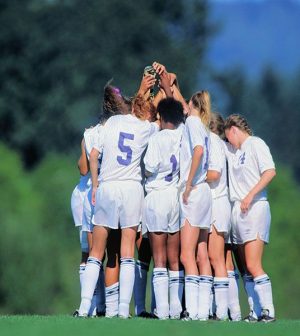- Navigating Your Midlife Crisis: Embracing New Possibilities
- City Raccoons Showing Signs of Domestication
- Mapping the Exposome: Science Broadens Focus to Environmental Disease Triggers
- One Week Less on Social Media Linked to Better Mental Health
- Your Brain Changes in Stages as You Age, Study Finds
- Some Suicide Victims Show No Typical Warning Signs, Study Finds
- ByHeart Formula Faces Lawsuits After Babies Sickened With Botulism
- Switch to Vegan Diet Could Cut Your Greenhouse Gas Emissions in Half
- Regular Bedtime Does Wonders for Blood Pressure
- Dining Alone Could Mean Worse Nutrition for Seniors
5 Steps to Protect Young Athletes’ Eyes

As children begin to return to their favorite sports, parents need to ensure that their youngsters use protective eyewear, a leading group of eye specialists says.
Nearly 30,000 people suffer sports-related eye injuries every year in the United States, but 90% of emergency room visits for such injuries could be prevented by protective eyewear, according to the American Academy of Ophthalmology.
Common sports-related eye injuries include corneal abrasions, bruising around the eye, retinal detachments and internal bleeding.
Even low-intensity sports activities carry some risk for eye injuries.
“Getting athletes of any age to wear protective eyewear is a challenge,” said Dr. Dianna Seldomridge, clinical spokesperson for the academy.
“Ophthalmologists hear all the reasons for not wearing eye protection: it’s cumbersome, it will impair peripheral vision, it will fog up. But sports goggles have vastly improved over the years. And if you start your kids early, wearing protective eyewear will become as natural as donning a batting helmet as they step up to the plate,” Seldomridge said in an academy news release.
The group offers the following eye safety tips for all athletes:
- Check and follow sport-specific requirements and standards regarding eye protection.
- Replace eyewear that’s yellowed or damaged to ensure the best protection.
- For basketball, racquet sports, soccer and field hockey, wear protective eyewear with polycarbonate lenses.
- For snow or water sports, consider using eyewear with UV protection to protect against sunburn or glare.
- Athletes who wear contacts or glasses should still wear eye protection. Contacts and regular eyeglasses are not replacements for protective sports eyewear.
If you suffer an eye injury, seek medical attention immediately, even if the injury seems minor. Noticeable symptoms sometimes develop later.
More information
The U.S. National Eye Institute has more on sports and eye safety.
SOURCE: American Academy of Ophthalmology, news release, April 20, 2021
Source: HealthDay
Copyright © 2025 HealthDay. All rights reserved.










